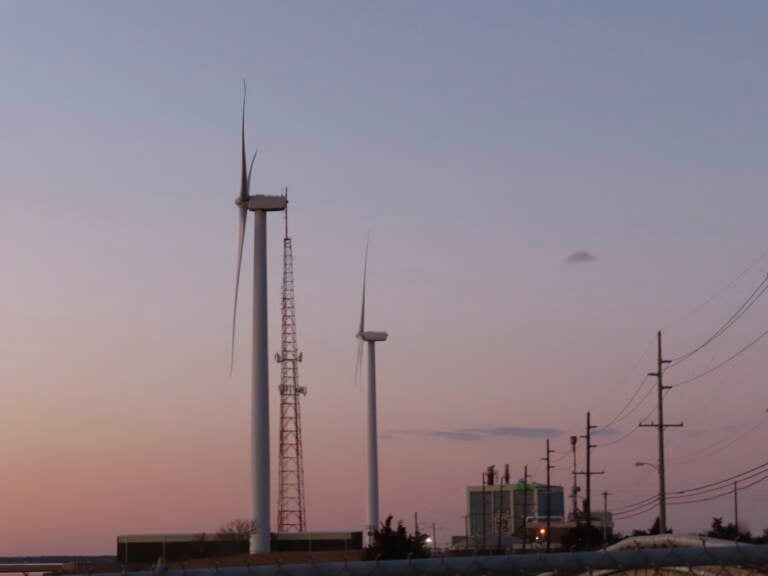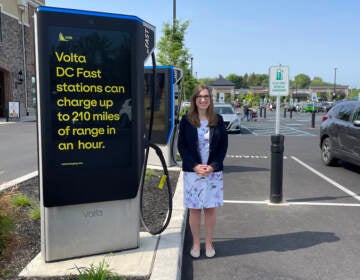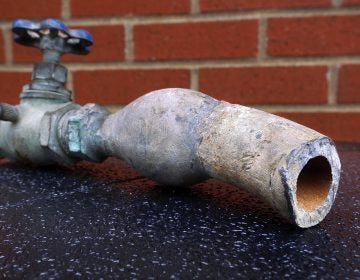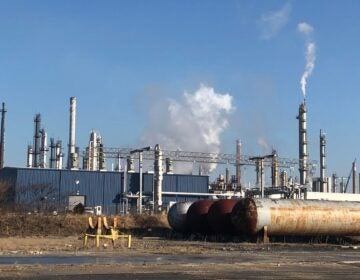Delaware lawmakers want state to assess offshore wind potential
The legislation would direct DNREC to evaluate the potential benefits and roadblocks of offshore wind.
Listen 1:15
The sun sets behind a land-based wind farm in Atlantic City, N.J. on Feb. 10, 2022. (AP Photo/Wayne Parry)
This story is part of the WHYY News Climate Desk, bringing you news and solutions for our changing region.
From the Poconos to the Jersey Shore to the mouth of the Delaware Bay, what do you want to know about climate change? What would you like us to cover? Get in touch.
Lawmakers in Delaware advanced legislation last week that would direct the state to evaluate the feasibility of offshore wind.
The bill, sponsored by state Sen. Stephanie Hansen, a Democrat, would direct the state Department of Natural Resources and Environmental Control to analyze the cost impacts and environmental benefits of offshore wind, and assess potential standards for obtaining electricity for such projects.
“As a state, we have nearly all of our renewable energy eggs in one basket — and that basket is solar. And it’s not a good place to be,” Hansen said.
“We need to diversify the renewables that we can rely on going forward, whether that means an offshore wind project by Delaware, or taking advantage of job opportunities, and transmission and energy, from offshore wind projects in nearby states.”
The measure, which received a 20-1 vote in the Senate, has been applauded by environmental groups in the state that hope it could lead to offshore wind projects in the future.
“This is a way to reduce emissions. Improving air quality means improving human health. It means lowering health care costs,” said Mark Nardone, director of advocacy for the Delaware Nature Society. “There are tremendous benefits from having wind, regardless of where you stand on climate change.”
Though the legislation doesn’t commit to offshore wind, Republican state Sen. Bryant Richardson voted against it — citing his concerns that wind turbines might impact wildlife.
In 2018, a task force established by Gov. John Carney to evaluate the potential for offshore wind in Delaware determined procuring these projects would be too costly. However, prices have changed since then, said Willett Kempton, a University of Delaware professor of marine science and policy, who has studied offshore wind since 2006.
Kempton is a member of the Special Initiative on Offshore Wind, which recommends Delaware take on an 800 megawatt offshore wind project. That’s the same size as the first commercial offshore wind project off the coast of Massachusetts. The independent organization found that the 2018 task force report was based on prices that were well above the market cost of electricity.
“The industry has changed tremendously since then — it’s in the range of half or two thirds of the price then,” Kempton said. “If the procurement is done well, Delaware could purchase offshore wind electricity at the same price, approximately, as they purchase natural gas power right now.”
In order to develop offshore wind in a cost-effective manner, procurement plans should minimize risk to the developer, establish clear criteria for evaluating bids, and allow for competition among bidders based on price, he said. Though Hansen’s legislation doesn’t formalize a procurement process, it lays the potential framework.
Delaware is the only state between North Carolina and Massachusetts that doesn’t have a formal wind policy or procurement process, Kempton said.
DNREC would be tasked to determine the potential cost burden on ratepayers, the economic benefits, the ability to reduce greenhouse gasses and improve health, the state’s capability for offshore wind projects and the impacts they would have on the electricity transmission system.
The agency said the legislation would codify research it has already begun, and wouldn’t require additional funding.
It could take about five years combined to finalize procurement, go through a bidding and contracting process, and for offshore wind companies to obtain the required permits, Kempton said. Offshore wind turbines could be built in about two years, he said.
Kempton argues it would be worth the wait. Three of these projects could run 100% of the electricity for the state, he said.
“We’ve got asthma, lung diseases, and so forth that are caused by power plant emissions. When you put a large new source of clean power onto the grid, you necessarily have to turn off other power plants,” Kempton said. “So, the value of savings in health, and the value of the CO2 reduction, is about the same as what we’re paying for power.”
Hansen’s legislation now advances to the House. If passed, DNREC would have until December 31 to present its report.

Get daily updates from WHYY News!
WHYY is your source for fact-based, in-depth journalism and information. As a nonprofit organization, we rely on financial support from readers like you. Please give today.







